Mastering the Craft of Homemade Hamburger Patties


Recipe Overview
Crafting the perfect homemade hamburger patty is more than just cooking; it’s an art form that can elevate your culinary skills to new heights. This guideline will dive into the nuances of creating flavorful patties that would make even a seasoned chef nod in approval.
- Creative Name: The Juicy Gourmet Burger
- Yields: 4 hearty patties
- Prep Time: 15 minutes
- Cook Time: 10 minutes
- Complexity: Easy
Main Ingredients
- 1 lb ground beef (80/20 blend recommended)
- 1 tsp kosher salt
- 1/2 tsp black pepper
- 1 tsp garlic powder
- 1 tbsp Worcestershire sauce
- Optional: diced onions, chopped herbs, or your favorite spices
Step-by-Step Instructions
Preparing the Ingredients
- Select the Meat: When it comes to burgers, fat content is key. An 80/20 blend of ground beef balances flavor and juiciness. For a twist, try ground lamb or turkey as an alternative.
- Chop Add-ins: If you’re feeling adventurous, finely chop some onions or incorporate fresh herbs like parsley. Keep the pieces small for even distribution throughout the patty.
- Seasoning: Combine the salt, pepper, garlic powder, and Worcestershire sauce in a bowl with the meat. Be gentle when mixing; overworking can lead to a tough patty.
Shaping the Patties
- Forming: Divide the mixture into four equal parts. Roll each part into a ball and then flatten gently into a round shape. A tip is to make the center slightly thinner than the edges. This helps them cook evenly and avoid puffing up.
- Dimple Technique: Make a small indentation in the center of each patty with your thumb. This can prevent the patties from bulging in the center while cooking.
Cooking the Patties
- Cooking Method: You can grill, pan-fry, or even broil your burgers. For a classic taste, a charcoal grill often provides the best flavor. Preheat your grill or skillet.
- Cooking Time: Cook each patty for about five minutes on one side. Flip and cook for an additional three to five minutes for medium doneness.
- Check Temperature: For safety, ensure the internal temperature reaches at least 160°F (71°C).
Nutritional Information
For each Juicy Gourmet Burger, expect a hearty intake:
- Calories: Approximately 280 per patty
- Protein: 22 g
- Fats: 21 g
- Carbohydrates: 0 g
- Nutrient Highlights: Rich in iron and B vitamins which are essential for metabolism and energy production.
Quick Cooking Tips
- Utilize Kitchen Gadgets: An air fryer or an Instant Pot can be a time-saver when making large batches.
- Multitask Effectively: While the patties cook, you can prep sides like a quick salad or fries to serve along with your burgers.
- Healthier Alternatives: Swap in ground turkey or chicken for a leaner track, or even consider using black beans for a vegetarian version.
Related Recipes & Variations
- Classic Cheeseburger: Add your choice of cheese during the last minute of cooking.
- Spicy Sriracha Burger: Mix Sriracha into your patty mixture for some heat.
- Vegetarian Option: Utilize chickpeas or lentils to crafted hearty plant-based patties.
Remember to share your unique creations or sub you made in the recipe! Elevating the classic hamburger can be a delightful culinary adventure.
Prolusion to Hamburger Patties
In the realm of culinary creation, few dishes surpass the homemade hamburger patty in versatility and satisfaction. The coaxing aroma of patties sizzling away on a grill or in a pan draws people together, transcending age and culture. This article aims to delve into every facet of crafting hamburger patties, from selecting the ideal meat cuts to understanding how different cooking techniques can lift your burger experience.
Grasping the importance of homemade patties extends beyond mere flavour; it’s about connection and mastery. Each process—from selecting the beef or turkey to choosing the right spices—holds significance, allowing cooks to personalize their burgers according to taste and preference.
Consider these benefits of learning how to make your own patties:
- Quality Control: You decide the meat quality, fat content, and seasonings, ensuring freshness and flavour.
- Customization: Cook up a storm with personal fillings or unique seasoning blends tailored to individual palates.
- Cost-Effective: Making burgers at home often saves money in the long run, particularly for those frequenting family meals.
- Healthier Choices: Choosing lean meats or going vegetarian opens up avenues for healthier burger options.
Ultimately, mastering the art of crafting patties serves as a gateway into the broader culinary world. It's a building block that can lead to exploring countless flavour combinations and cooking techniques. Now, let’s peel back the layers of history behind this beloved culinary staple.
Choosing the Right Meat
When it comes to crafting flavorful hamburger patties, the choice of meat plays a pivotal role. Selecting the right meat is not just about personal preference; it's about the texture, flavor, and even health considerations that can elevate your burger experience. Each type of meat brings its unique characteristics, influencing how your patty cooks and tastes.
Types of Meat Options
Beef
Beef has long been the heavyweight champion in the burger arena. Its rich flavor and satisfying juiciness make it a top pick for many burger enthusiasts. The main characteristic of beef is its high fat content, which not only lends to its flavor but also contributes to a satisfying mouthfeel that is often associated with gourmet burgers. One of the unique features of beef is its versatility—there are numerous cuts you can choose from, ranging from chuck to sirloin. However, the downside can include higher calorie content, depending on the cut selected.
Pork
Pork is another excellent option, often celebrated for its sweetness and tenderness. Ground pork can add a delightful, somewhat distinctive flavor to your burger patties compared to its beef counterpart. The key characteristic of pork is its ability to meld well with different spices and seasonings, making it exceptionally adaptable for various flavors. While it can be a scrumptious choice, cooks should keep an eye on fat content—too much can yield grease-heavy burgers that may not be appealing to all.
Turkey
For those looking for a lean alternative, turkey can be a fantastic option. It’s leaner than beef, making it a favored choice for health-conscious individuals. This meat can offer a mild flavor that easily absorbs spices and seasonings, allowing for creativity in your patty crafting. However, turkey can dry out easily if overcooked, leading to a less satisfying burger experience. Thus, careful cooking is essential when choosing this meat.
Vegetarian Options
The rise of plant-based diets has brought about a surge in vegetarian burger options. These patties can be made from various ingredients including beans, lentils, and even quinoa. Their biggest advantage is often health-related, as they tend to contain less fat and more fiber. They also cater to a broader audience, making them useful for gatherings with diverse dietary preferences. However, achieving the same juicy texture and rich flavor found in meat patties can sometimes be a challenge.
Fat Content Considerations
Lean vs. Fatty Cuts
The choice between lean and fatty cuts of meat is crucial in burger making. Lean cuts, though healthier, can lead to drier patties if not cooked carefully. On the other hand, fatty cuts provide that coveted juiciness and flavor but can push the calorie count to higher levels. The key here is to find a balance based on your audience and occasion. A blend, such as using a 80/20 mix of lean to fatty, can strike a perfect compromise.
Texture and Flavor
Texture and flavor are two sides of the same coin when it comes to burgers. Fat content directly impacts both; more fat typically means greater juiciness and flavor, whereas leaner options may require additional ingredients—like moisture-retaining vegetables—to enhance the burger experience. Understanding these nuances can guide you in selecting the meat that aligns with your culinary goals while satisfying your taste buds.
"The heart of any great burger lies in the meat—know it well to perfect your craft."
Selecting the right meat ultimately lays the foundation for a delicious homemade hamburger. Each choice provides a distinct taste and texture profile that can influence the final product. . As we continue, you'll see how seasoning and cooking methods further bring those meat choices to life.
Essential Seasoning Techniques
When it comes to crafting a memorable homemade hamburger patty, seasoning is not just a step in the process; it is the linchpin that can make or break the flavor profile of your burger. The right seasoning techniques not only enhance the natural taste of the meat but also add layers of complexity that can transform a simple meal into a culinary experience. Essentially, seasoning acts as an amplifier, elevating the beef's inherent flavors while providing a tantalizing kick. The balance of flavors is paramount, and understanding how to achieve that will set your patties apart from the mass-produced alternatives.
Basic Seasoning Mix
Salt and Pepper
Salt and pepper are the dynamic duo of seasoning, the two staples that lay the foundation for any great dish. As simple as they might seem, these two ingredients play an outsized role in amplifying the natural flavors of the meat. Salt not only adds a savoriness but also helps to enhance the juiciness of the patties. It draws moisture towards the surface and can even change the texture for a more tender bite.
Pepper, on the other hand, adds a bit of heat and depth that can significantly influence the overall taste. Using freshly cracked black pepper is often considered superior because of its vibrant flavor compared to pre-ground varieties.
One of the unique features of this basic pairing is its versatility. You can easily adjust the levels based on personal preference, helping you fine-tune your burger experience. However, be cautious — overdoing it can lead to a gravelly mouthful that overshadows the beef itself.
Garlic Powder

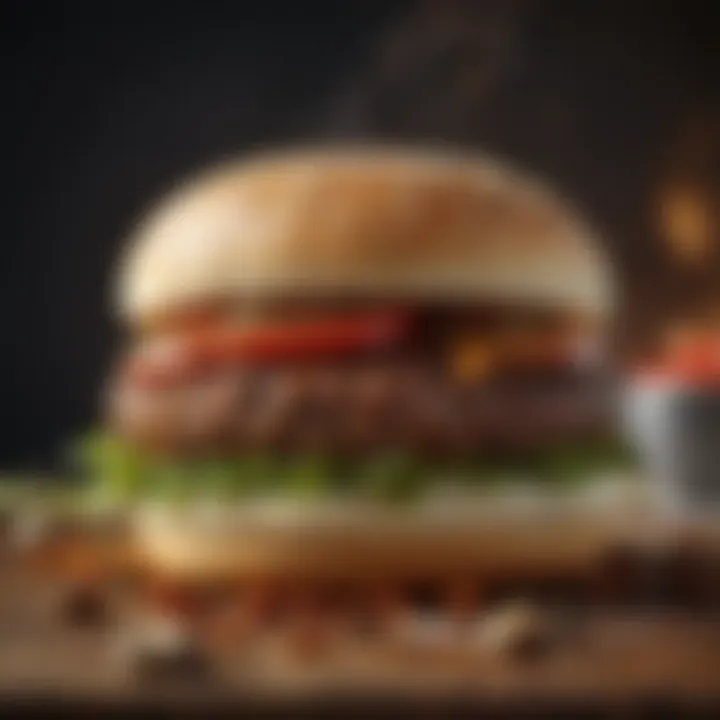
Garlic powder delivers a punch of flavor that can’t be overlooked. Its rich, earthy taste complements beef wonderfully, giving it a complex depth that raw garlic cannot always achieve. The powdered form allows for a more even distribution throughout the patty, ensuring consistent flavor with each bite.
A standout characteristic of garlic powder is its convenience. It’s shelf-stable and lends itself to easy measurement, unlike fresh garlic which may require more effort to work with. The unique flavor profile it brings to the table makes it a popular choice among home cooks and chefs alike.
Yet, it’s worth noting that garlic powder can easily overpower if used excessively. A delicate touch is needed to strike the right balance. Too much can lead to a pungent taste, overshadowing the natural meat flavors.
Advanced Flavor Profiles
Herbs and Spices
Taking a step further into the realm of advanced flavor profiles, incorporating herbs and spices opens a world of possibilities. Think about fresh parsley, thyme, or even a sprinkle of smoked paprika. These additions not only brighten the overall flavor but also introduce aromatic qualities that can enhance the sensory experience.
A key highlight of using herbs and spices is their ability to transform a basic beef patty into something uniquely personal. Many individuals have begun to explore regional spice blends, making their burgers reflect distinct culinary traditions. The opportunities are almost endless — from Italian herbs to spicy chipotle powders, the choice of herbs can elevate the burger far beyond the expected.
Yet, careful consideration must be given to the amounts used. Too many spices can muddy the flavor, leading to an unbalanced patty that lacks the kernel of beefy essence.
Specialty Sauces
Specialty sauces represent another innovative approach to seasoning your patties. Think of a tangy barbecue sauce or a zesty aioli as ways to inject personality into your burger. These sauces advantageously work as flavor enhancers, harmonizing with the meat while adding moisture and additional notes that keep the palate intrigued.
One of the standout characteristics of specialty sauces is their ability to be easily made at home, allowing for complete customization. You can play with the components to suit your taste, perhaps incorporating a hint of sriracha for some heat or adding in some honey to balance the tanginess.
However, gauging the quantity of sauce is essential. Too much can overpower the natural burger flavor, making it difficult to appreciate the craftsmanship that went into creating the patty.
Ultimately, mastering the art of seasoning your hamburger patty is akin to creating a symphony. Each element must be balanced against the others to deliver a harmonious experience on the plate.
Forming the Perfect Patty
Creating your own hamburger patties is an art, and the way we form them plays a crucial role in that masterpiece. It's not just about tossing some seasoned meat into a pan; the shape and thickness of your patty can influence its texture, cooking time, and overall flavor experience. Understanding the essentials of forming a perfect patty not only enhances the cooking process but also elevates the final dish. There’s a clever balance between aesthetics and functionality; a well-formed patty will not only look appetizing but also deliver a satisfying bite.
Shaping Techniques
Hand Forming
Hand forming is perhaps one of the most traditional ways of shaping hamburger patties. It allows for a personal touch, which many home cooks appreciate. When you shape a patty by hand, you can gauge the texture of the meat as you go, making it easier to adjust and ensure uniformity in size—something particularly important if you’re making multiple patties for a gathering.
One key characteristic of hand forming is the ability to create slight indentations in the center of each patty. This is essential, as it prevents the patty from puffing up while cooking. While it may sound trivial, you’d be surprised how many people overlook this small detail.
However, hand forming isn’t without its downsides. It can be time-consuming, especially if you’re cooking for a crowd. For casual weekend barbecues, that’s usually not a big deal, but on busier weekdays, it might feel like a chore.
Using a Patty Press
On the other hand, using a patty press can be a game changer for those who prioritize speed and uniformity. These nifty gadgets allow you to produce perfectly shaped patties with minimal effort. One of their standout features is the ability to control the thickness and diameter, which is especially beneficial if you are one to experiment with different cooking times.
For those who might be doubtful about the quality of a patty made using a press, fret not. A good-quality patty press allows for a level of compression that retains the meat's juices. Yet, keep in mind that too much pressure can lead to a denser texture, which some folks may find less appealing.
In summary, whether you opt for hand forming or a patty press heavily depends on your personal preferences and the time you have on hand. Each method has its own perks and pitfalls, but what matters most is achieving a desirable end result when it comes to flavor and experience.
Achieving the Right Thickness
When it comes to hamburger patties, size does matter, and thickness is the name of the game. Ideally, a patty should be neither too thick nor too thin. Aim for about three-quarters of an inch thick, as this usually ensures a juicy interior while still achieving that coveted crispy exterior.
A properly-thick patty ensures even cooking throughout. Thin patties tend to cook faster, which might leave you with a dry mouthful, while excessively thick patties can lead to an undercooked center, raising safety concerns.
When cooking, remember to keep an eye on the grill or skillet—don’t get distracted! The right thickness combined with the right cooking method can transform a simple patty into a coveted culinary delight.
"The secret to a great burger lies in its formation—size and shape count as much as the quality of the meat itself."
So as you embark on your quest of crafting the perfect hamburger patty, pay attention to these shaping techniques and thickness guides. With a little practice and a keen eye, you’ll be well on your way to becoming a patty-making pro!
Cooking Methods for Hamburger Patties
When it comes to crafting the perfect hamburger patty, the method of cooking plays a pivotal role in determining not just the flavor but also the texture and juiciness. Choosing the right cooking method for your patties can elevate an average burger into a mouthwatering masterpiece. Each technique has its unique characteristics and benefits, and understanding these can help you make informed choices that suit your palate and lifestyle.
Grilling
Grilling is perhaps the quintessential method for cooking hamburger patties, often associated with sizzling summer cookouts and smoky flavor. The high heat of the grill allows the exterior of the patty to caramelize beautifully while sealing in the juices. This technique creates a delightful contrast between the crusty surface and the tender interior.
However, there are a few considerations to keep in mind. First, ensuring the grill is preheated is essential to prevent sticking and achieve those coveted grill marks. Also, keeping a close watch on the temperature is vital; a burger cooked on too high heat can quickly char on the outside while remaining raw on the inside. The use of a quality spatula can make flipping easier without damaging the patty.
Also, grilling adds a specific smoky flavor that can be enhanced by adding wood chips, such as hickory or applewood, to the grill.
"The moment you hear that beloved sizzle, you know you’re one step closer to burger heaven."
Pan-Frying
If the grill is not accessible, pan-frying is a fantastic alternative that can yield surprisingly delicious results. Cooking your patties in a skillet allows for better control over the heat and ensures an even cook. Using a cast-iron skillet can enhance the crispiness of the patty while still allowing it to remain juicy.
To achieve the best outcome, use enough oil or butter to coat the bottom of the pan. This not only helps prevent sticking but also contributes to a rich, golden-brown crust. One common mistake is flipping the patty too frequently; patience is key. Allow the patty to sear properly on one side before flipping it. This method also gives you the advantage of adding onions or mushrooms to the pan, allowing them to caramelize alongside the meat, creating a depth of flavor that is hard to beat.
Baking
Baking may not be the first technique that comes to mind when thinking of burgers, but it certainly has its perks, especially for those looking for a healthier approach. Cooking patties in the oven allows for even cooking without the need for additional fats. This method is extremely helpful for meal prepping, keeping them warm and ready for use throughout the week.
To bake patties, preheat your oven to about 375°F (190°C) and place the patties on a baking sheet lined with parchment paper. This reduces cleanup time and allows for proper air circulation, which aides in even cooking. Depending on your preference, they can bake for about 20 minutes or until they reach your desired doneness.
While baking doesn't impart the same smoky flavor as grilling, it opens doors to creative seasoning and pairing options that can compensate for that missing touch. Experimenting with marinades or basting with a tangy barbecue sauce in the final minutes of baking can enhance flavor in unexpected ways.
Achieving the Ideal Doneness
Getting the doneness of your hamburger patty just right is crucial. It can make or break your burger experience. Each level of doneness brings distinct flavors, textures, and characteristics that can be savored in every bite. When you're crafting your homemade patties, knowing how to achieve that perfect doneness means you can cater to different palates and preferences, ultimately making your culinary efforts stand out.
It’s not just about cooking the meat for the sake of it; it’s about understanding what each doneness means and how it plays a part in flavor development and juiciness. Each step in the cooking process contributes to the final product. Let’s look at each doneness level - rare, medium, and well-done - to comprehend their significance in our burger-making journey.
Understanding Meat Temperatures
Rare
Rare is often the darling of meat enthusiasts. Cooked to an internal temperature of about 120-125°F (49-52°C), it retains a bright red, warm center. This choice makes a statement and caters perfectly to those who enjoy the beef's natural flavor and tenderness. The key characteristic of rare is its juiciness. When biting into a rare patty, you’re met with rich flavors and the delightful warmth of the meat.
While some may find the raw edges unsettling, many prefer the minimal cooking that preserves the beef's essence. If you’re a true burger aficionado, this doneness embodies that classic, unadulterated beef experience. The unique feature of rare tends to be its texture, as the meat remains soft and moist, begging to be devoured in simple form. However, it’s worth noting that such cooking requires high-quality meat to avoid risks associated with undercooked beef.
Medium
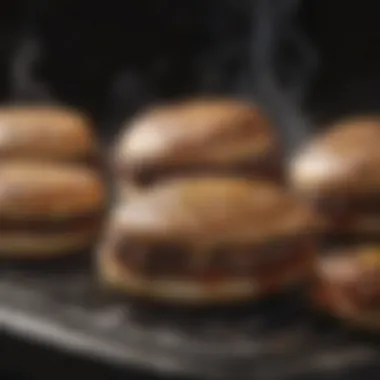
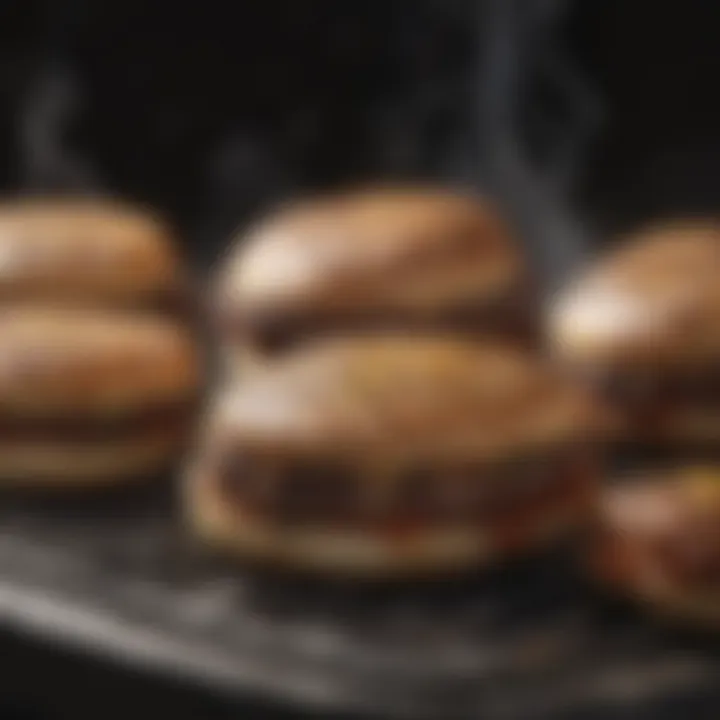
Then we have medium, the popular middle ground, landing between 130-135°F (54-57°C). Many will tell you this is the sweet spot. The meat showcases a warm pink center, striking a balance between juiciness and cooked flavor. The appeal lies in the fact that it’s charred nicely on the outside while still being tender within. Medium patties offer an engaging texture that beautifully dances between firmness and relinquished moisture.
Those who appreciate a bit of a crust yet crave meat that's not too pink will adore medium. It’s a versatile choice, pleasing a wide audience without straying too far into the undercooked realm. Additionally, the fat within the beef begins to render at this temperature, enhancing flavor. The unique appeal here is its adaptability—grill it, pan-fry it, or bake it, and still manage to keep that juicy essence. Just be aware that cooking to medium requires monitoring to prevent hitting that overcooked mark.
Well-Done
Lastly, we meet well-done, where the internal temperature climbs above 160°F (71°C). This patty boasts a charred exterior and a firm texture. For some, this choice means assurance that the meat is cooked thoroughly, eliminating any worry about food safety. With its no-pink interior, it caters largely to more cautious eaters. The absence of moisture can sometimes impact flavor, pushing well-done to a more contested position among burger lovers.
Still, there’s value in well-done. Folks who appreciate a ‘crunchy’ bite will find that well-done patties provide that satisfying texture while potentially harboring caramelized flavors. The unique feature of well-done is its resilience; it can hold up under various toppings and sauces without falling apart easily. Cooks aiming for this doneness should note that the key here lies in cooking gently and allowing it to rest, ensuring it doesn’t dry out excessively.
Using a Meat Thermometer
Using a meat thermometer is essential for all these doneness levels. It allows for precision, taking away the guesswork. Insert the thermometer into the center of the patty for the most accurate reading. Without it, you could easily end up with overcooked or undercooked meat.
To summarize, understanding the levels of doneness is paramount in crafting the ultimate homemade hamburger patty. Whether you fancy the juicy rush of rare, the balanced bite of medium, or the hearty satisfaction of well-done, it’s all about personal preference and understanding your audience's tastes. Be it the experience of savoring pure beef flavor or the thrill of watching juices escape as you bite down, mastering these techniques will elevate your burger game.
Enhancing Your Patty Experience
When it comes to homemade hamburger patties, enhancing your patty experience isn’t just about what goes inside the meat. This aspect of burger crafting revolves around the whole assembly – the bun, the toppings, and the kind of sides you choose to accompany your creation. By paying attention to these factors, you elevate the simple act of burger-making into a gourmet affair right at your own home. It’s about complementing flavors, textures, and even dietary needs, making your meal feel complete and satisfying.
Choosing the Right Buns
Classic Buns
Classic buns are the traditional pick for any hamburger lover. Their slightly sweet flavor and soft texture provide a perfect base for a juicy patty. The best characteristic of classic buns lies in their ability to absorb juices without losing structural integrity, ensuring that your burger experience is messy, yet manageable. This style is often made from enriched white bread, providing a slightly chewy mouthfeel that contrasts beautifully with the tenderness of the meat. Often baked to a golden brown, these buns tend to be a crowd-pleaser.
One unique feature of classic buns could be their versatility. They can hold their own whether the toppings are simple, like just a slice of cheese, or elaborate, with lots of different sauces and vegetables piled high. However, one disadvantage is that they may not cater to those with gluten sensitivities.
Gluten-Free Options
As dietary needs become more diverse, gluten-free buns are gaining traction. Made from almond flour, rice flour, or even a mix of various gluten-free grains, they provide a suitable alternative for those who can't consume gluten. The key characteristic of these buns is their ability to mimic the texture of bread while ensuring it is safe for all to enjoy. They also cater to those following a gluten-free diet for health reasons, allowing everyone to join in on the burger fun.
However, the challenge with gluten-free buns often lies in their texture. Without gluten, these buns can sometimes be more crumbly, making it essential to choose quality brands or recipes that yield a robust product. For those who succeed, the flavor combinations and toppings available still allow for an enjoyable burger experience.
Accompaniments and Toppings
Cheese Choices
Cheese adds richness and creaminess to a burger. From classics like American or cheddar to gourmet options like blue cheese and gouda, cheese is a layer of flavor you shouldn’t overlook. The fantastic melting quality of cheeses like American ensures that they fuse beautifully with the warm patty, while others, like feta or goat cheese, can introduce a tanginess that cuts through the richness, enhancing your bite.
The key feature of cheese choices is their ability to transform the entire flavor profile of a burger. You get the creamy melt, and sometimes, even a contrast of textures, depending on what you opt for. However, do note that some might prefer a cheese-less burger, so considering your guests' preferences is essential.
Fresh Vegetables
Fresh vegetables are crucial for adding crunch and freshness. Think of lettuce, tomatoes, onions, or even pickles. Fresh vegetables contribute a contrast to the warmth of the patty, providing that necessary crunch. Their presence can lighten heavy flavors and introduce a refreshing aspect to each bite.
The great opportunity with fresh vegetables is the variety they can bring. You can choose classic iceberg lettuce for crispness or opt for arugula for a peppery kick. However, some vegetables hold more moisture than others, which can make your bun soggy if added too early in the process.
Condiments
Condiments can be a game-changer in your burger-making journey. From the usual ketchup and mustard to more elaborate sauces like aiolis or barbecue, these additions enhance flavors in ways that can completely redefine your burger. Each condiment has its unique characteristic that can either match or contrast the patty's flavors.
A benefit of condiments is the customization they offer. You can keep it simple or construct a burger that tells a flavor story with layers of sauces and dips. Yet, using too many can overwhelm the true flavors of your carefully crafted patty, so moderation is key.
"When it comes to burgers, every little component counts. The bun, the toppings, the condiments – they all play a role in the final bite. Don't skimp on these details!"
By understanding the importance of these components in your burger-building process, you're on your way to creating a meal that's not only satisfying but leaves a lasting impression.
Storing Leftover Patties
When you put in all the effort to create luscious hamburger patties, it only makes sense to store any leftovers properly. Understanding how to store leftover patties correctly not only prevents waste but also ensures you have delicious meals ready for your next craving. Proper storage keeps the flavors intact and maintains the quality you worked so hard to achieve.
Refrigeration Guidelines
Refrigerating leftover patties is often the quickest method to keep them fresh for a short period. The ideal approach is to let the patties cool to room temperature before sealing them up. Once cooled, wrap the patties in plastic wrap or place them in an airtight container. This vital step of letting them cool prevents condensation, which could lead to sogginess, taking a toll on the patty’s texture.
Store them in the fridge, where they should last for about three to four days. If you find yourself with a plethora of patties, make sure to separate layers with parchment paper; this will save you the trouble of ripping them apart later.
"Leftover patties can quickly turn into a gourmet surprise with the right method of storage."
Freezing Techniques
If you suspect you won’t get through all your leftover patties within a few days, freezing is your best bet. To freeze effectively, again let the patties cool down completely. Then you can opt for a couple of different methods. One method is to wrap each patty individually in foil, then place them in a resealable freezer bag. Remember to remove as much air as possible to keep freezer burn at bay.
Another option is to lay them flat on a baking sheet lined with parchment paper, freeze them for a couple of hours, and then transfer them to an airtight container or bag without letting them stick together. This way, you can grab a single patty without needing to defrost a whole batch. Frozen patties can last up to three months.
In summary, the way you store your leftover patties can significantly impact your future meals. Following these guidelines ensures that you savor each bite of your homemade creation even days later.
Healthy Variations of Hamburger Patties
When it comes to enjoying a delicious hamburger, health consciousness may often come into play. The different variations of homemade hamburger patties not only cater to diverse dietary needs but also offer a chance to delight the palate without compromising on nutrition. Embracing these healthier alternatives can lead to a more balanced diet, allowing culinary enthusiasts to relish their favorite meals while keeping an eye on overall health.
Lean Meat Alternatives
Opting for lean meat alternatives can significantly reduce fat intake, but it doesn't have to mean sacrificing flavor. Here are some popular choices:
- Ground Turkey: Lean, flavorful, and easy to cook with. It provides a great base for various seasonings.
- Ground Chicken: Similar to turkey, must maintain a careful balance of moisture to avoid dry patties. A sprinkle of herbs can elevate its taste.
- Pork: When using ground pork, lean cuts can be selected to dodge excessive fat, although the flavor profile is usually richer and tastier.
Moreover, utilizing these lean meats shouldn’t be a confusing process. It’s advisable to mix in some chopped vegetables or even fruits, like grated zucchini or apple, to boost moisture and flavor. Another key consideration is to combine different types of meat—notably, ground beef with turkey. This way, you can maintain some of the traditional richness while toning down the fat.
Plant-Based Patties
As folks become more health-conscious or opt for a plant-based diet, the market has seen a surge in plant-based patties. Here's how you can create your own:
- Black Beans: A staple in many kitchens, black beans are high in protein and fiber. They mash up easily and can be mixed with breadcrumbs and spices for a delightful texture.
- Lentils: Similar to black beans, lentils offer a rich source of nutrients. They can form an excellent base for patties when cooked and seasoned correctly.
- Chickpeas: Ground chickpeas may give you a flavorful and satisfying alternative. Just season them well and add a bit of flaxseed meal to bind them together.
Plant-based patties are not just for vegans or vegetarians. They're for anyone looking to lessen their meat consumption while exploring new flavors and textures. A well-seasoned plant-based patty can leave everyone satisfied, even those who typically gravitate towards meat.
"Switching to healthier variations can open up a whole new world of flavors and textures, while still keeping comfort food in the realm of possibility."
In summary, the introduction of healthy variations in hamburger patties encourages a shift from traditional expectations to more inclusive options that cater to various palates and lifestyles. By making informed choices like lean meats or plant-based ingredients, one can create burgers that don’t just fill the belly, but also feed the body well.
Common Mistakes in Patty Making
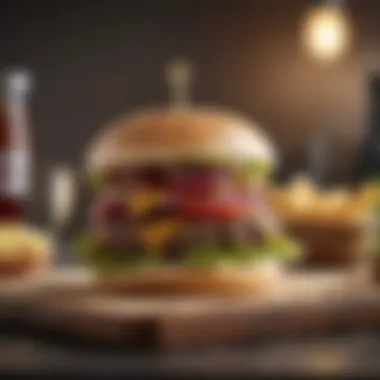
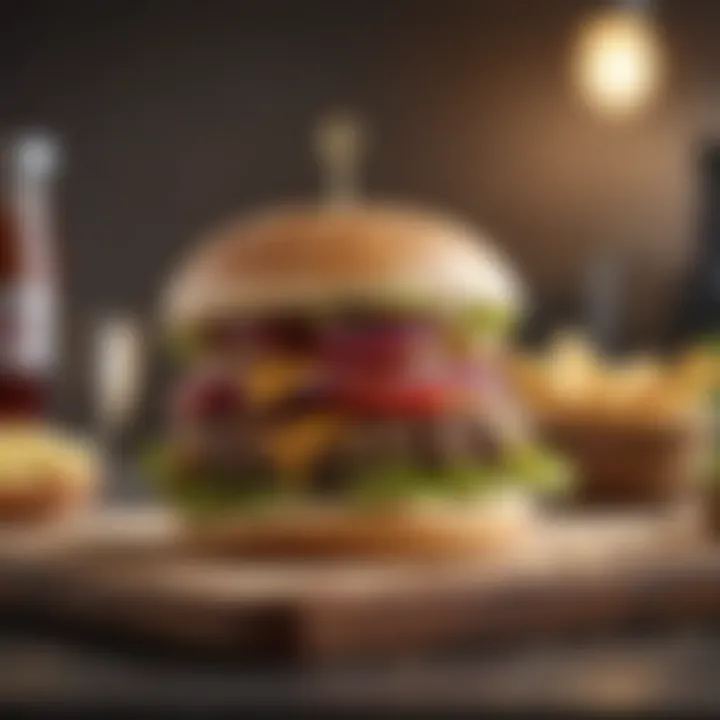
Crafting the perfect hamburger patty is a skill that can significantly elevate any cooking experience. However, many novice cooks and even some seasoned chefs often slip into common pitfalls that can mar the quality of their homemade burgers. Understanding these missteps is crucial for anyone looking to create mouthwatering patties that leave a lasting impression. Let's delve into the most prevalent mistakes and how to avoid them to ensure your culinary endeavor does not flop.
Over-Seasening
One of the quickest ways to ruin a good hamburger patty is through over-seasoning. It’s all too easy to go heavy-handed with spices, especially when trying to enhance flavor. However, this can lead to a taste explosion that overwhelms the natural meat flavor. Ideally, seasoning should complement, not dominate.
- Judging the right amount: A sprinkling of salt and pepper can work wonders, but remember that you can always add more if needed. Start with a modest amount; for instance, about half a teaspoon of salt per pound of meat is a good guideline.
- Balancing flavors: Don’t forget that other ingredients in your burger toppings contribute flavors too. If you're using a sharp cheddar cheese or a tangy sauce, you might want to dial back the seasonings to balance everything out.
- Experimenting rather than overdoing: Instead of pouring in a ton of spices, try blending small amounts of different herbs and forming a balance. Things like smoked paprika, onion powder, or even minced garlic can add depth without drowning out the main component – the meat.
"A little seasoning goes a long way, and overdoing it can cross you off the flavor map."
Proper seasoning is an art, and once mastered, it can truly highlight the rich flavors of your patty.
Improper Cooking Techniques
Another massive mistake that so many folks are guilty of is improper cooking techniques. Cooking hamburgers isn’t just about throwing them on a grill; it requires some finesse.
- Cooking too fast: Some people crank the heat way up to cook patties quickly, thinking they can finish faster. While it may seem like a smart idea, high heat can cause the outside to char while leaving the inside undercooked. Instead, medium heat is generally your best friend. It allows for even cooking and a delicious crust without jeopardizing your patty’s interior.
- Flipping too soon: There’s a saying in cooking: "If it’s sticking, it’s not ready yet." Resist the urge to flip your patty before it creates a proper crust. Give it time; three to four minutes on one side usually yields better results before you flip.
- Not letting it rest: Once your patties are off the heat, it’s tempting to dive right in. However, resting patties for a few minutes allows juices to redistribute evenly throughout, making for a juicy bite. Cutting into them too quickly can release all those savory juices onto your plate instead of savoring them with your burger.
By avoiding these common mistakes, you can elevate your burger-making game, allowing your homemade patties to shine without being masked by errors. A thoughtful approach to seasoning and cooking ensures your burgers not only taste great but also leave a lasting impression.
Cooking for Special Diets
When it comes to the culinary world, accommodating special diets is more than just a trend; it's a necessity. Many individuals follow specific dietary guidelines due to health issues, lifestyle choices, or ethical concerns. Understanding how to craft homemade hamburger patties that comply with these diverse diets can open a world of culinary creativity and satisfaction without sacrificing flavor or texture.
Diverse Diets and Their Requirements
Cooking for special diets not only broadens the scope of who can enjoy a good burger but also encourages creativity in the kitchen. Whether an individual is seeking low-carb alternatives, managing their weight, or trying to minimize inflammation, creating specialized patties can cater to these needs effectively. This inclusivity ensures that everyone can join in on social gatherings around the grill or the dinner table, sharing good food without feeling left out.
Keto Burger Patties
The ketogenic diet is characterized by a low carbohydrate intake, which can make things a bit tricky for traditional burger lovers. But fear not! Crafting keto-friendly burger patties is possible with a few simple adjustments.
- Meat Choices: Opt for a base of high-fat meats like ground beef, chuck, or even lamb. These provide the flavor and richness needed while keeping the carb count low. Adding bacon bits or using blends like beef and pork can also up the flavor profile.
- Bound with Eggs or Cheese: To avoid fillers commonly found in traditional patties, mix in eggs or cheese to bind your ingredients. This adds moisture and flavor, helping the patties achieve that perfect texture.
- Seasoning and Toppings: Be mindful of sauces and toppings. Opt for sugar-free condiments like mustard or avocado instead of ketchup. Adding fresh herbs, jalapeños, or avocado can also boost flavors without adding carbs.
"Cooking for a ketogenic diet doesn’t mean sacrificing taste; it’s about emphasizing bold flavors and quality ingredients."
Paleo Options
The Paleo diet focuses on whole foods reminiscent of what our ancestors might have eaten. When crafting hamburger patties for those adhering to this lifestyle, the main goal is to stick to natural ingredients.
- Quality Meat: Use grass-fed beef, free-range pork, or even wild game for your base. These options not only align with dietary preferences but also enhance the overall taste of the burger.
- No Fillers: Avoid breadcrumbs or any kind of grain-based fillers. Instead, consider using finely chopped vegetables, herbs, or even nuts as a binding agent. This practice not only keeps it Paleo but nudges the taste toward a fresh and vibrant profile.
- Grill with Flavor: Season your patties simply with salt and pepper, with perhaps a dash of smoked paprika or rosemary. Emphasizing the quality of the meat is key here, so less is often more.
Pairing Beverages with Hamburger Patties
In the world of gastronomy, pairing food with the right beverages elevates the entire dining experience. When it comes to homemade hamburger patties, the right drink can amplify the flavor and make each bite more enjoyable. It's not merely a matter of quenching thirst; it's about crafting a balanced sensory experience. The richness of the patty, be it beef, turkey, or a plant-based option, needs a counterpart that complements without overwhelming. Think of it as a dance, where each partner must move in harmony.
Here are a few factors to consider when choosing beverages to accompany your burgers:
- Flavor Profiles: The drink should either match the flavors of the patty or contrast them in an interesting manner. For instance, a smoky barbecue burger pairs well with a beverage that has a bit of tanginess.
- Texture: The carbonation in beers could cut through the richness of fattier meats, offering a refreshing balance, while a creamy milkshake can add another layer of richness.
- Temperature: A cold drink can contrast nicely with the warmth of a freshly cooked patty, enhancing the experience.
Ultimately, the choice of beverage can enhance the overall meal and foster conversations that go beyond just taste.
Beer Pairings
When it comes to pairing beer with your hamburger patties, you have no shortage of choices. Beer is a classic companion to burgers, providing a plethora of flavors and textures that can enhance the meal. Here are some examples:
- Pale Ales: These have a balanced flavor profile with a hint of bitterness that goes well with a juicy beef patty. The light hops can brighten the taste.
- Porter or Stout: The rich, robust flavors of stouts can complement meatiness, especially in char-grilled patties, giving a delightful contrast.
- Wheat Beers: If you're going with turkey or veggie patties, a crisp wheat beer can provide a light, refreshing counterpoint.
- IPA: For spice lovers, an IPA with its hoppy bitterness can stand up to and even complement spicy toppings.
In essence, the best beer for your burger is one that enhances its flavor, rather than clashing with it. Experimenting with different matches can lead to delightful discoveries.
Non-Alcoholic Options
Not everyone wants to indulge in alcohol, and thankfully, there are plenty of non-alcoholic options that can pair beautifully with a hamburger. Here are some noteworthy choices:
- Sparkling Water: A good, fizzy sparkling water can cleanse the palate between bites, making it a refreshing choice.
- Kombucha: This fermented tea provides a slightly tangy, effervescent kick that pairs well with nearly any burger.
- Iced Tea: Unsweetened iced tea with a slice of lemon can offer a smooth, refreshing experience that complements the savory flavors.
- Craft Sodas: Consider artisanal sodas that have natural ingredients. The unique flavors can add an interesting twist without the alcohol.
The idea is to ensure that whatever you're sipping on doesn’t overshadow the burger but rather, works in tandem to present a coherent meal.
"Good food deserves good drink; it transforms a simple meal into a memorable occasion."
By thoughtfully pairing your beverages with hamburger patties, you can create a more satisfying and well-rounded meal experience.
Patty Presentation
Presenting a homemade hamburger patty isn’t just about how it looks on the plate; it creates an experience that can elevate a simple meal into a culinary delight. The way a burger is plated can affect how appetizing it appears, changing not only the visual appeal but also the anticipation of that first bite. Every detail matters, from the dish you choose to the condiments used. It’s an opportunity to showcase the effort and care put into making the patties, reflecting both the quality of ingredients and the skill involved in preparing them.
Effective presentation can also encourage more mindful eating. As individuals savor and appreciate the visual aspects of their meal, they may take more time to enjoy their food, making the act of dining a more pleasurable experience.
Moreover, with social media playing such a significant role in today’s food culture, a beautifully presented patty might just be the star of your next post. It draws admiration from followers and adds that extra layer of joy to home cooking. In a nutshell, investing time in presentation not only pleases the guests but can also spark inspiration among fellow culinary enthusiasts.
Plating Techniques
When it comes to plating homemade hamburger patties, the choices can be as diverse as they are personal. Here are a few tried-and-true techniques:
- Choice of Plate: A wooden board instills a rustic vibe, while a sleek white plate conveys elegance. Think about the mood you want to set.
- Layering: Start by placing the bun to establish a base. Layer the lettuce leaf next and then the patty, making sure to position the patty in the center of the bun for a balanced look.
- Space Utilization: Avoid overcrowding the plate. Leave some negative space that draws the eye naturally to the burger.
- Color Contrast: A simple addition of vibrant condiments, or a slice of pickled jalapeño, can take the visual experience up a notch.
- Height Variation: Combine different heights in the presentation, such as stacking the toppings, to create a dynamic appeal.
By mastering these plating techniques, you can impress your dining companions with a simple yet effective presentation that showcases your patties in the best light.
Garnishing Ideas
Garnishing is the icing on the cake that not only beautifies the plate but also enhances flavors. When it comes to hamburgers, the right garnishes can make all the difference. Here are valuable ideas:
- Greens: Fresh herbs like parsley or cilantro can bring a burst of color. Sprinkle some around the plate or on top of the patty for a fresh finish.
- Slice of Tomato: A quartered cherry tomato can act as a refreshing contrast and adds a juicy bite.
- Onion Rings: Place an onion ring on top or beside the burger for an appealing crunch and a hint of sweetness that complements the savory aspects of the patty.
- Artistic Drizzle: Use a squeeze bottle to create sauces, like aioli or chipotle mayo, in a decorative pattern on the plate around the burger.
- Pickles: Add a few dill pickle slices beside your burger. Their bright green color and tangy flavor offer both a visual and taste enhancement.
The End
Summary of Key Points
Throughout this guide, we delved into vital aspects that contribute to making exceptional hamburger patties:
- Choosing the Right Meat: Picking high-quality meat that suits your taste and dietary needs sets the foundation for a delicious burger. Moisture, flavor, and texture depend significantly on meat choice and fat content.
- Essential Seasoning Techniques: Seasoning isn't just an afterthought; the right blend can transform an ordinary patty into something extraordinary. Techniques learned within this section can dramatically enhance the flavor of your burgers.
- Cooking Methods: Knowing how to cook patties properly affects doneness and juiciness while preserving flavor. Whether you choose grilling, pan-frying, or baking, each method comes with its unique charm.
- Storing Leftovers: Emphasizing proper storage methods not only minimizes waste but also ensures that the delicious work you've put in doesn't go to waste.
- Innovations in Healthy Variations: Exploring alternatives to traditional meat patties, like plant-based options, allows for inclusivity and creativity in the kitchen. This aspect appeals to a variety of dietary preferences and restrictions.
Encouragement for Innovation
As you stand ready to put learning into practice, remember that experimentation is the key to success in the kitchen. Don’t hesitate to try new combinations, whether it’s a different type of protein, a surprising seasoning blend, or an unconventional cooking technique. The world of homemade hamburger patties is vast and ripe for innovation.
"Cooking, at its essence, is the art of discovery. Each patty presents a blank canvas. Your creativity is the brush."
Hitting the culinary sweet spot often involves some trial and error, and that’s part of the magic. When you boldly step outside the lines of conventional recipes, you might stumble upon a flavor that becomes your signature. Share your triumphs (and mishaps) with fellow culinary enthusiasts, whether through platforms like Reddit, Facebook or even a casual chat at your local diner. The burger is not just food; it’s a way to bring people together, to share stories and tastes.
In closing, this guide serves as the stepping stone into the realm of burger-making. As you venture forth, may you enjoy every sizzle, spice, and bite of the homemade creations you bring to life.







